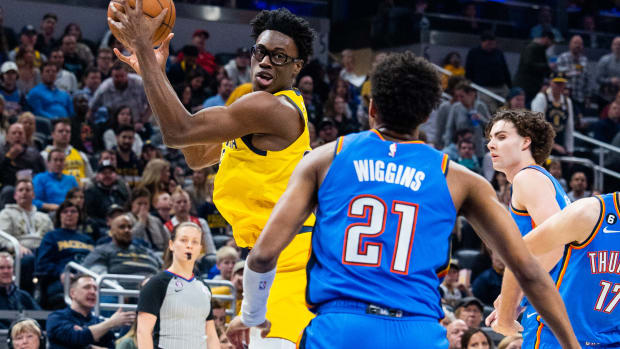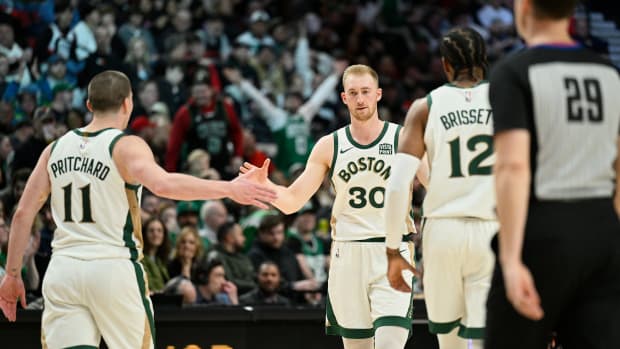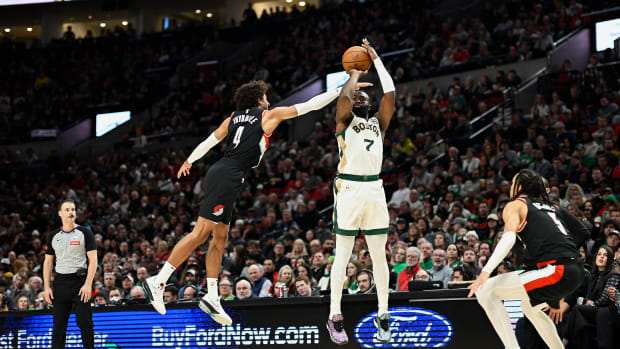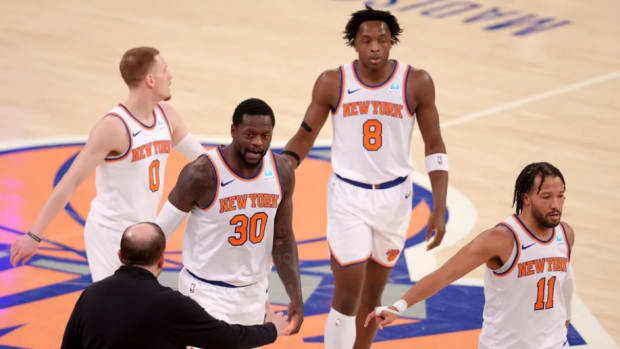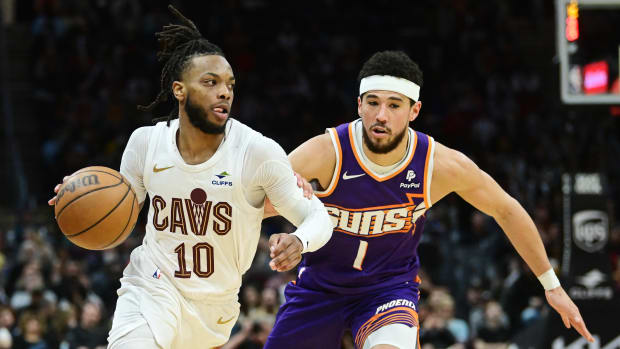Ja Morant looks comfortable. It’s January, about 45 minutes before tip-off at FedExForum, and a throng of fans has arrived early to watch this NBA season’s most electric performer amble through a series of jump shots. For Morant, the spotlight burns brighter every night. But here, wearing a sleeveless, white Grizzlies hoodie, he seems oblivious to the attention, as if he was jogging around the blacktop in his backyard on a lazy Saturday morning. Or, better yet, Morant appears ready to take a test he already has the answers for. At the crowd’s fore is his father, Tee, seated courtside behind Versace sunglasses. As Ja’s harshest judge, Tee used to embed himself with rival fans, hoping to glean criticisms about his son’s game that he could then turn around and deploy as his own. Now he’s able to sit back and enjoy the show.
In five years, Morant has gone from a scrawny after-thought at a public high school in South Carolina to someone who can stake a claim as the face of a championship contender. At 22 years old, competing in the NBA’s smallest TV market, he was an All-Star starter who received more votes than any other guard in the Western Conference with the exception of Steph Curry; his jersey has become the league’s seventh-highest seller after not ranking in the top 15 a year ago.
“I know he had the potential since probably the age of 6 to be special in this game,” says Tee, who transforms into the mayor of Memphis when he stands up, unable to walk five feet without stopping to shake a hand or pose for a photo. “But at this magnitude? Nah. I thought it would be a longer process.”
Today, no player on Earth better concretizes the idea that basketball peaks when it leans into improvisation; Morant, at 6' 3", 174 pounds, warps the floor by exploring outlandish angles and ungodly ball fakes that precede an indelible package of finishing moves. His athleticism yields aesthetic forefathers (e.g., Allen Iverson) and career paths he aspires to imitate (e.g., Dwyane Wade), but after accounting for his size, age, efficiency and, now, team success, historical comparisons are an amalgamation.
Call it a leap if you’d like, but this year has felt more like liftoff. And by getting where he is so fast—with a startling spike in usage, scoring and PER that underscores his case for MVP—everything that was previously expected when Morant won Rookie of the Year in 2020 has grown exponentially. “Think of the best point guards ever,” Grizzlies forward Jaren Jackson Jr. says. “He could end up being the best point guard to play this game. He’s definitely on track for that.”
Morant, of course, is unfazed. About 10 minutes into his pregame routine, he serves up an appetizer to the fans. With the nonchalance of a man whose vertical leap pushes 47 inches, he ends the rehearsal by reverse-jamming a self-alley-oop off the backboard.
Morant’s ascent isn’t an accident.
“I don’t know if everyone in the NBA works hard,” Grizzlies wing Dillon Brooks says. “I’m gonna keep it real. What I’ve seen is his growth and how he works. At first he was going through the motions, like most NBA guys do. . . . Now you see him, he’s unguardable.”
The spark for his sudden rise came a few months before the season began, when Morant grew convinced that to unlock parts of his talent that nobody, including himself, had ever seen, he’d need to embrace a place most people tend to avoid: the Dark.
Morant’s initial taste of the NBA playoffs last spring was bittersweet. The only player to score more points than his 73 in their first two postseason games was George Mikan (in 1949). But the Grizzlies lost in five games to the Jazz in Round 1. Two days after they were eliminated, Morant sat down with Grizzlies coach Taylor Jenkins and made clear he wasn’t satisfied. “He had another level in this game that he could take himself,” Jenkins says. “Another level of his leadership, his work ethic, everything.”
After that meeting, Grizzlies assistant coach Blake Ahearn, an avid reader, gave Morant a book called Win in the Dark by Joshua Medcalf and Lucas Jadin. One of several passages caught Morant’s eye: “The dark is where you transform into a version of yourself you never dreamed possible. . . . We quietly and relentlessly train in the dark with complete trust that our moment under the bright lights will come. Welcome to the dark.”
Morant ingested the message and made it an offseason ethos, informing his private trainers Trey Draper, Jonathan Thomas and Mo Wells that his regimen wasn’t meant for public consumption. Morant didn’t want anyone to witness his progress, be it on social media or in person. “Welcome to the Dark?” Wells says. “That’s album mode.”
Morant spent parts of the summer in Memphis, Las Vegas and L.A. But most of his sweat was poured at House of Athlete, a facility located just north of Miami in Weston, Fla. It resembles an airplane hangar, with 30-foot ceilings and black walls. In South Florida, the Dark went from figurative mantra to literal experience. Behind the main gym, Morant escaped sunshine in a dim studio that was softly illuminated by neon-blue lamps. “Sometimes they had the lights on, and if Ja came in we would just tell them, ‘Make it dark, man,’ ” Draper says. ‘We’re working in the dark.’ ”
(While in L.A., Morant broke his own rule by hopping in a pickup game with a few other NBA players; he turned down the next invitation. “He was like, ‘Nah, I ain’t going back to that. I don’t want them to see what I’m working on,’ ” his uncle, Phil Morant, remembers Ja saying. “Basically, ‘I don’t want to give none of them no cheat codes.’ ”)
For nearly five hours a day, Morant prioritized his game and his physique. He’d lift weights, endure balance and coordination training and sharpen his vision with headsets designed to enhance cognition and response times.
To prolong the hang time that allows him to make shots on the way down over defenders who’ve already landed, Morant developed his power by sprinting. He’d hop on a curved treadmill or zip around a small chamber that simulates altitude. According to Wells, Morant has the straight-line speed of a track star and could probably still add another inch or two to his vertical leap, but the goal instead is to sustain what he already does. “I don’t need him to touch his head on the top of the backboard,” he says. “I need him to be consistent at the rim.”
On the court, twice a day, Morant polished strengths (such as ballhandling) and homed in on areas of weakness. There was a near overload of shooting drills that imitated what he sees in a game: pick-and-roll pull-ups, driving layups and the parachute floater that defenses have no answer for.
Everything was counted. Sessions usually didn’t end until at least 400 shots went in and between 750 and 800 were cast. That includes threes. Last year, Morant was the NBA’s seventh-worst three-point shooter among all players who took at least 200. Over the summer, that shortcoming was attacked with repetition. Morant wasn’t allowed to stop any workout until he made eight jumpers in a row from seven separate spots along the perimeter.
To brace himself for a season of downhill drives, they’d re-create the contact he’d face in an actual game. Dribbling off ball screens, Morant felt four to six hands on him at all times before he was pounded at the rim with a pad, often wielded by his dad. They wouldn’t move on to the next drill until he made seven or eight out of 10.
While he rested at night, the work didn’t stop. Morant studied how opponents guarded him and the Grizzlies last year. “He’s an elephant,” Draper says. “He remembers every single detail.”
The early work paid dividends, as confidence in his outside shot made Morant one of the league’s premier offensive weapons to start the season. But a month in, he was forced back to the Dark much sooner than expected. The spectacle we’ve seen since was so close to never happening at all.

Morant’s teammates understand Ja is the star of the show, and they’re happy to fit in alongside him—while enjoying his gifts.
John W. McDonough/Sports Illustrated
When he was 6, Morant fell off a trampoline and broke his arm. Tee was at work when he got a call from his sister. He could hear Ja screaming in the background. “I’m talking about, he broke it bad,” Tee says. “Like, his elbow pushed up towards his shoulder.” On the drive to the hospital, Tee tried to calm his son down. “You gotta be a big man for me. You gotta be a big boy for me,” he says. Then: “This dude, in all his pain, found a way to stop crying.”
As a result of the accident, Ja’s left arm is an inch or two longer than his right. (To this day he drives left twice as often as he does with his dominant hand. “He goes left every time because he can reach out farther,” says Shaq Buchanan, Morant’s college roommate and guard for the G League’s Memphis Hustle.)
This childhood story is another way to say that Morant has always been tough, raised with a “throw some dirt on it” attitude. He had his knee scoped before the draft, fractured his thumb in the Orlando bubble and badly sprained his ankle in Brooklyn at the end of 2020. None of those injuries sidelined him as doctors expected them to. But they also didn’t pose the same threat as what happened the day after Thanksgiving.
At FedExForum, Morant tried crossing over Hawks guard Kevin Huerter and thought he heard his knee pop. Morant limped along the baseline to Memphis’s bench and was carried to the locker room. At halftime, the entire team walked into the training room to console him. Given his high pain tolerance and the fact that there was no contact involved, everyone who could see the look on his face feared the worst. “I didn’t want to keep playing that day,” Jackson says. “I just kind of was over it. I wasn’t in the mood.”
When MRI results revealed only a sprained MCL and a three-to-four- week initial timetable, relief swept over the organization. In Wells’s view, Morant’s genes and offseason workouts—in which they focused on landing mechanics, deceleration, reacceleration and exercises that strengthened his lower back and feet—helped him avoid a more devastating setback. “Anybody else probably would’ve tore their MCL,” he says. (About a week after the injury, Tee says Morant was already dunking.)
Wells traveled to Memphis and told Morant to treat his time off as if it was another offseason training block to get even stronger. If not for COVID-19, which he contracted while out, Morant would’ve likely made his return within a couple of weeks. But that stretch wound up being a blessing in disguise. In addition to rehabbing his knee, Morant put himself through two-a-day workouts—some at midnight—that better prepared his body for the rest of this season. He lifted, ran on an underwater treadmill and addressed inflammation in his plantar fascia with additional exercise.
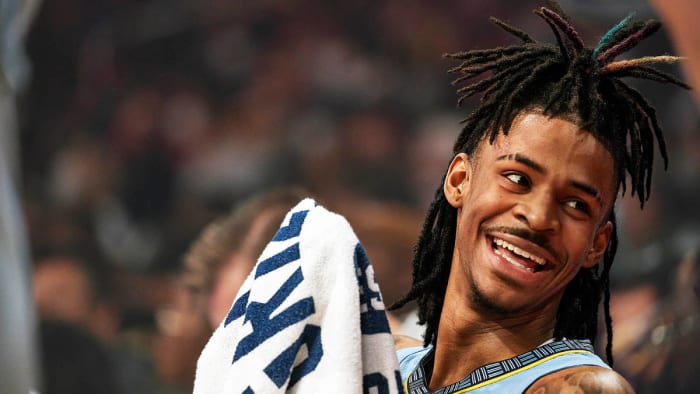
With his third-year leap, Morant has brought joy to the Grizzlies franchise, the city of Memphis and the entire NBA. And he might just be scratching the surface.
John W. McDonough/Sports Illustrated
More time in the Dark did Morant good. Shortly after coming back, there was The Block, where, in an instant, he embodied a popping champagne cork to pin Lakers guard Avery Bradley’s layup at the top of the box. “They called a timeout and got his deodorant off the backboard,” Tee says.
When the Grizzlies went 10–2 while Morant nursed his knee, nobody on the roster felt confused about whose team it was. “It’s not him trying to come back and fit in,” Grizzlies guard Desmond Bane says about that stretch. “He’s a superstar, and we’re the pieces that are fitting in around him.”
Before his knee injury, Morant averaged 14.1 points per game in the paint. From his return up until the All-Star break, that number increased to a whopping 18.0. Morant leads the NBA in this category while scoring more around the basket than any guard in a quarter century.
“I don’t fear nobody, dawg,” Morant says after scoring 26 points (all nine of his field goals came in the paint) in a January win in Cleveland against the NBA’s most intimidating interior defense. “I don’t care if you’re 7' 7" or whatever. I’m coming straight at you.”
That statement (and others Morant has made this year) evokes the type of authenticity that endears him to fans and the organization he speaks for. He tiptoes up to the line of arrogance and only occasionally crosses over with a petty persona that’s underscored by undying self-belief and a deep obsession with proving nonbelievers wrong. After he dunked on Magic center Robin Lopez, Morant commemorated the flush on Instagram with a coffin emoji and “graveyard” location tag.
“He’s literally telling you to your face, Welcome to the Dark,” Brooks says. “There’s guys that are good in this league that can showcase their talents but are really reserved, and when people start getting into their s--- they kind of push back and be like, ‘O.K., I’ll get it the next game.’ But him, he just hits the adversity and tries to power through it, regardless of what it is.”
Anthony Tolliver, a 13-year NBA veteran who played for the Grizzlies during Morant’s rookie season and still talks to him today, saw leadership traits in Ja that reminded him of a young Steph Curry, a Warriors teammate in 2009. “He’s confident, but he’s humble,” Tolliver says about Morant. “And that’s a great combination to have.”
Winning is the priority. “That was one of the things that I took away from Steph his rookie year,” Tolliver continues. “If I hit two or three shots in a row and he has the ball in his hands, he doesn’t say, ‘Anthony got his; now it’s my turn.’ He would never have that mindset. . . . I saw that same thing in Ja when I was with the Grizzlies.”
Morant hasn’t changed. “I don’t hunt shots,” he says. “My teammates actually yell at me if I’m not being aggressive.” At the end of an overtime loss in Philadelphia, he whipped a no-look pass to rookie wing Ziaire Williams with the game on the line. When it missed, Morant didn’t second-guess himself. Instead he told reporters how much he believed in Williams, then held himself accountable for the loss: “If it’s anybody you want to be mad at,” Morant says, “it can be me.”
Those words mean something from someone who doesn’t traffic in lip service. In December, Brooks had Morant as his Secret Santa. He received two tennis chains from Icebox, a gift that obliterated the team’s price limit of $200. “When it comes time for Christmas, everybody wants to have Ja as their Secret Santa,” he says. “He’s such a generous person. He knows exactly what you want, what you need.”
Morant often picks up the tab at team dinners and hosts BBQs at the home he shares with his parents and sister. Family is everything to Ja. So is loyalty. When Draper was furloughed at the start of the pandemic, Morant called to offer a full-time position as his skills trainer. As a rookie, he welcomed Niele Ivey before any other player when she became the first female coach in Grizzlies history.
In his role as Memphis’s vocal leader, Morant’s intellect doesn’t hurt. “His ability to read the game is second to none,” says Jenkins, recounting a breakfast the two shared before a game against the Mavericks in which Morant suggested a defensive strategy he saw the Warriors deploy with success against Luka Dončić earlier this season. “He’s a savant.
“I don’t even know where he’s going when he cuts sometimes. But he has done a great job when it comes to him saying, ‘Hey, wait for this, I’m gonna cut here, I’m gonna space here or I’m gonna set my screener up. The dialogue has gone to a whole other level with our team, and a lot of that is him.”

Morant may be 6' 3", but he’s more productive in the paint than anyone in the league. “I don’t fear nobody, dawg,” he says.
Greg Nelson/Sports Illustrated
When imbued by a superstar, selfless qualities can foster the sort of chemistry that’s critical for any team that believes it’s at the dawn of a potential dynasty. Morant’s talent makes him an MVP candidate, but his principles have turned him into a quintessential franchise pillar. It’s the type of impact that hasn’t gone unnoticed by one of the greatest point guards ever.
“When you got that ability that he has,” Suns guard Chris Paul says, “when you can hoop and play and still feel like you’re in the backyard but you in the NBA? The sky’s always the limit.”
His dad envisions multiple championships, MVP trophies and Olympic gold medals. Jackson thinks Morant will eventually average a triple double. Morant’s agent, Jim Tanner, believes he can be the face of the league. In the meantime no draw in basketball is more compelling.
During the first quarter of a game in Philadelphia, Morant launched his body from the dotted line and collided with 6' 10", 279-pound Andre Drummond in front of the rim, drawing a foul, a solid outcome.
But on the next play Morant jogged past his dad’s seat only to hear criticism. I would’ve dunked that! Tee barked.
Morant stared back at him: I ain’t even out the bed yet.
In the third quarter, after Morant reeled off a string of showy baskets, he ran by the same spot. This time, it was his turn to howl so everyone nearby could hear. I’m up now! I’m up now!
It could be a while before he comes back down.
More SI Daily Covers:
• Can Overtime Disrupt Basketball With ... Twins?
• How Miles Bridges Put Himself in Perfect Position
• Michael Jordan's Return With the Wizards, 20 Years Later

































